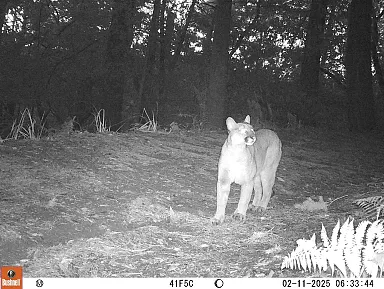
Busting Myths About Pumas
- Author: Sean Verdi
- Publication Date: September 26, 2025
- Related Project: Bay Area Puma Project
- Focus Species: Puma concolor (Mountain Lion)
Historically, the mountain lion (Puma concolor) occupied nearly every region of North America, but today its distribution has been greatly reduced due to habitat loss, fragmentation, and human persecution. Despite their ecological importance as apex predators, pumas often evoke fear, a perception largely driven by misinformation rather than scientific evidence. Media portrayals frequently exaggerate their threat to humans, overshadowing the fact that attacks are exceedingly rare. Advancing coexistence with pumas depends on accurate knowledge, which helps dispel myths, reduce conflict, and promote effective conservation strategies.
Myth 1: Pumas pose a serious threat to people
Despite their reputation, puma attacks on humans are exceedingly rare. In the past century, fewer than 30 fatal incidents have been confirmed across North America, a risk far lower than that posed by domestic dogs, bees, or deer-vehicle collisions. In fact, people are statistically more likely to be injured or killed by deer, the very prey pumas hunt. Mountain lions are solitary, elusive, and primarily active at dawn and dusk, behaviors that minimize encounters with people. When conflicts do occur, they are most often associated with young, dispersing males or situations where natural prey is scarce. For most hikers and outdoor enthusiasts, the chance of even glimpsing a puma in the wild is slim.
Myth 2: Pumas decimate deer populations
While deer are a puma’s primary prey, scientific evidence shows that predation by mountain lions does not significantly reduce deer population sizes. Instead, pumas play an important ecological role by targeting older, weaker, or diseased individuals (Hornocker et al. 2010). This natural selection keeps herds healthier and prevents unchecked overgrazing that can reduce plant biodiversity. Deer populations are driven far more by habitat quality, climate, and human hunting pressure than by puma predation alone (Forrester & Wittmer 2024). Far from destructive, pumas act as regulators and stabilizers within ecosystems.
Myth 3: Removal of pumas makes communities safer
The removal of resident pumas often increases, rather than decreases, human–wildlife conflict. Adult males hold territories that exclude younger, riskier transients (Peebles et al, 2013). When these resident animals are killed, their absence allows multiple juveniles to move in, disrupting social structures and heightening the chances of livestock depredation or encounters near homes. Research consistently shows that non-lethal strategies—such as securing livestock at night, employing guardian dogs, and sustaining natural prey populations—are more effective at reducing conflict than culling (Miller et al. 2016). Keeping stable puma populations on the landscape benefits both people and wildlife.
Myth 4: Pumas don’t need much space
As wide-ranging carnivores, pumas require extensive habitat. Adult males may occupy territories exceeding 100 square miles, while females often use ranges closer to 50 square miles. Human development increasingly fragments these habitats, isolating populations and limiting genetic exchange (Benson et al. 2016). The story of P-22, the famous mountain lion of Los Angeles’ Griffith Park, illustrated the challenges of urban isolation, from inbreeding risks to the dangers of crossing busy highways. Wildlife crossings, such as the Wallis Annenberg Liberty Canyon overpass now under construction in California—offer critical solutions to reconnect fragmented populations and preserve genetic diversity (Goodyear 2017).
Towards coexistence
Living alongside pumas does not mean living in fear—it means embracing coexistence strategies that support both ecological balance and community safety. Public education, non-lethal conflict mitigation, and thoughtful urban planning are essential. Preserving habitat connectivity maintains genetic diversity and population resilience. As keystone predators, pumas regulate prey populations, reduce disease spread, and even help lower deer–vehicle collision risks. By replacing myths with evidence, we can move toward a future where America’s lions are recognized not as threats, but as vital neighbors in healthy ecosystems.
References
Benson, J.F., Sikich, J.A. and Riley, S.P. 2016. Individual and population level resource selection patterns of mountain lions preying on mule deer along an urban-wildland gradient. PLoS One, 11: e0158006.
Forrester, T.D. and Wittmer, H., 2024. Mountain Lion Predation on Mule and Black-tailed Deer: A Perspective on The Complex Impacts of An Iconic Predator. Canadian Wildlife Biology and Management. 13: 27-40.
Goodyear, D. 2017. Lions of Los Angeles .The New Yorker. https://www.newyorker.com/magazine/2017/02/13/lions-of-los-angeles
Hornocker, M. & Negri, S. 2010. Cougar: Ecology and Conservation. University of Chicago Press.
Miller, J.R., Stoner, K.J., Cejtin, M.R., Meyer, T.K., Middleton, A.D. and Schmitz, O.J. 2016. Effectiveness of contemporary techniques for reducing livestock depredations by large carnivores. Wildlife Society Bulletin, 40: 806-815.
Peebles, K.A., Wielgus, R.B., Maletzke, B.T. and Swanson, M.E., 2013. Effects of remedial sport hunting on cougar complaints and livestock depredations. PLoS one, 8: e79713.
Do You Have 2-4 Hours A Month To Preserve Your Local Ecosystem?
Our volunteers are the driving force behind making true change in ecosystem health and wild cat conservation. Some like to volunteer in the field, others help us maintain our online presence, and some work with events. With just a few hours a month, you can make a difference, too.
Make A Difference Right Now
As a 501(c)3 nonprofit, our work is only possible because of generous donors like you.
More than 90% of your donation will go directly to our groundbreaking research, outreach, and education programs.
This is where true change starts. If you’d like to be a part of it, make a donation to Felidae Conservation Fund today:
Or,
